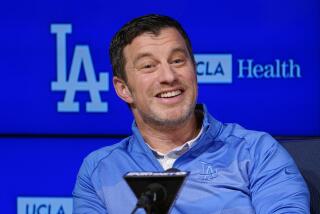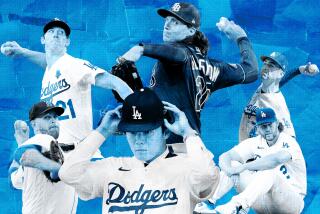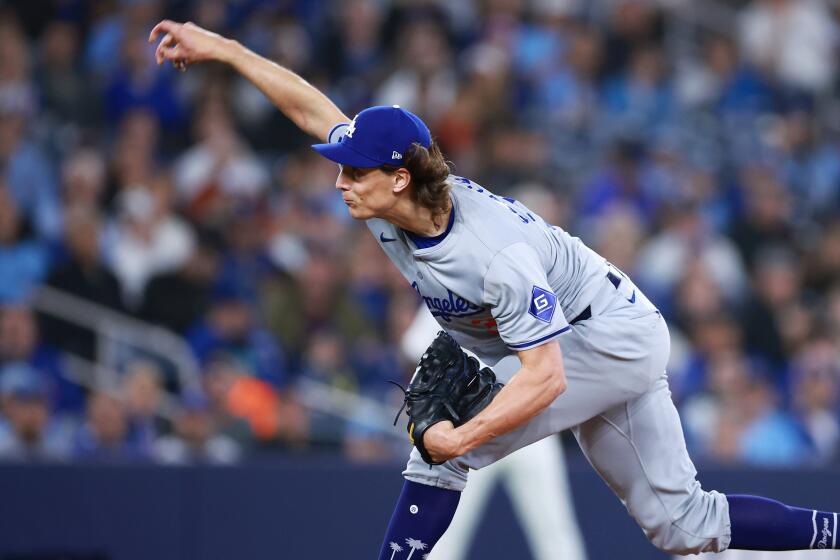The Dodgers’ brain trust has its own version of ‘Moneyball’
There is no shortage of ways to explain the Dodgers’ success this season, but Chicago Cubs manager Joe Maddon came up with a new one Wednesday.
“Their yin and their yang,” Maddon said.
That was Maddon’s way of saluting the Dodgers’ depth and preparation, and he used an adjective that might have been a pejorative a generation ago.
“They have it pretty much scripted before the game,” he said.
The Dodgers’ player payroll is the highest in baseball, but so is their front-office payroll. They have six current or former general managers in their baseball operations department — as well as team president Stan Kasten, the former general manager of the NBA’s Atlanta Hawks. The Dodgers also have 15 staffers in their research and development department.
In Dodger Land, it is almost nostalgic to envision a manager simply checking to see whether the opposing pitcher is right-handed or left-handed, then filling out the lineup card accordingly. Maddon noted that the Dodgers’ depth enables them to field a particular lineup based on which players best hit a high fastball, should an opposing pitcher specialize in that pitch.
Whatever is the yin of the opposing team’s strategy, the Dodgers seem to have a yang to complement and balance it, even if they summon the appropriate personnel from triple A for just that one game.
And, in the hours before each game, the Dodgers’ brain trust maps out the game in advance, and not just which players the team would use to counter a pitching change. The Dodgers’ bullpen use might be unconventional on any given day, but is not unplanned.
Roberts said he usually is joined by pitching coach Rick Honeycutt, bench coach Bob Geren, bullpen coach Josh Bard and various members of the front office, with reams of data available to provide probable outcomes for whatever situations might be envisioned.
“We kind of all just go out there and throw those crazy scenarios out there,” Roberts said, “whether it’s a first-inning ball off the shin, or an eighth-inning, 80-pitch performance by the starter. You go through their lineup and see every situation that might present itself.”
A generation ago, a general manager plopping into the manager’s office before each game with a binder of information might have been considered heresy. Roberts, who was well aware of how involved the front office would be when he took his job two years ago, considers it progress.
“To be able to lead, you’ve got to be able to listen,” he said. “I’ve got a lot of great people around, and we exchange a lot of great ideas and challenge each other. I think that’s healthy.”
That atmosphere has pervaded the clubhouse too, and the Dodgers cherish players who are receptive to information. For example, as soon as the Dodgers acquired pitcher Yu Darvish, general manager Farhan Zaidi shared data on how he might improve by altering which pitches he threw, where in the strike zone he threw them, and how often he threw them.
However, president of baseball operations Andrew Friedman said the Dodgers do not shove a gallon of data into the hands of players who want no more than a teaspoon of information.
“Our coaches do a terrific job of synthesizing the information and delivering it in nuggets to our players,” Friedman said. “Some want more, some want less. I think our coaches do a great job of really getting a feel of how to handle it with each individual.”
The most memorable strategy in Game 3: Roberts letting Darvish hit for himself in the sixth inning — with the bases loaded, a pinch-hitter ready, and the bullpen fresh — then drawing a bases-loaded walk. Had the Dodgers really planned out that situation?
“We didn’t get to that scenario,” Roberts said, chuckling. “That was probably 99% gut.”
Follow Bill Shaikin on Twitter @BillShaikin
More to Read
Are you a true-blue fan?
Get our Dodgers Dugout newsletter for insights, news and much more.
You may occasionally receive promotional content from the Los Angeles Times.







